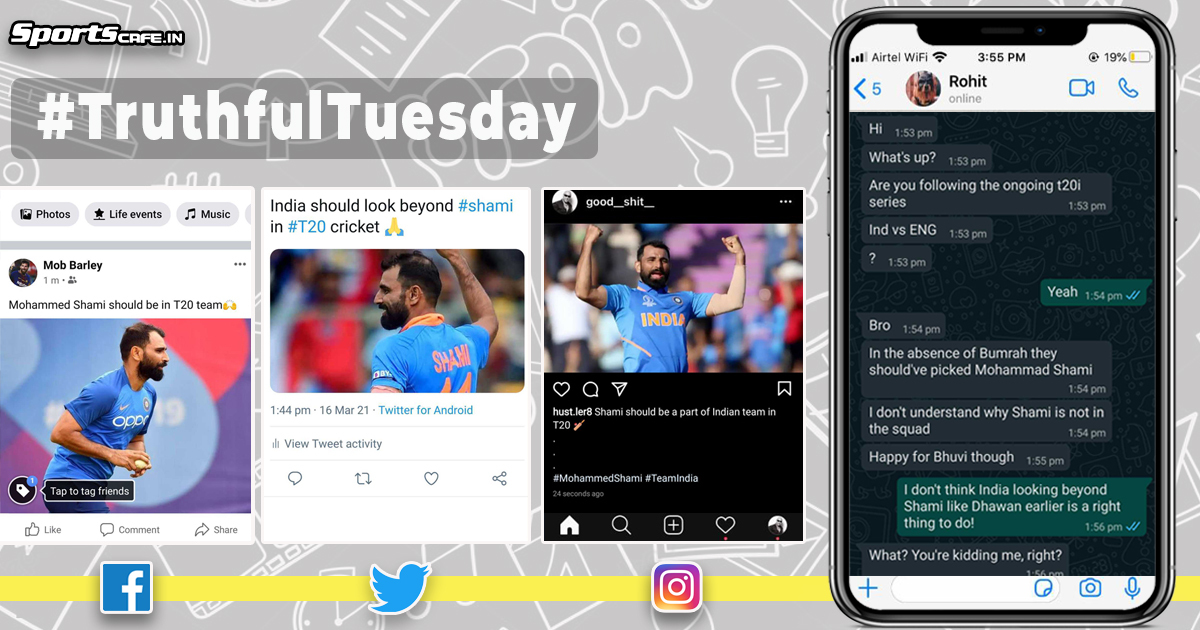Truthful Tuesday | Like Dhawan, it is time for India to start looking beyond Mohammed Shami in T20 cricket
On Sunday, team India took one of the biggest selection calls in recent memory by axing Shikhar Dhawan. We look at why, in a few months’ time, they might have to dish out a similar treatment to another experienced campaigner, Mohammed Shami.

It goes without saying that Shami is one of the finest all-format bowlers India have ever produced. Across formats he’s picked up 340 international wickets, he’s the first name on the team sheet in red-ball cricket when he’s fit and he’s represented the side in both 50 and 20-over World Cups in coloured clothing. However, this theory of Shami being a very good ‘all-format’ bowler floats around only because of the fact that he is world-class in five-day cricket and 50-over cricket.
For he is and has always been, like Dhawan, an average-at-best customer in the shortest format. That he is still a regular in T20Is when fit is largely down to his exploits in the other two formats; in other words, it’s his reputation - and not performance - that has earned him a spot in the side. There are a host of factors that debunk the theory that Shami is a valuable asset in T20 cricket and we’ll get to them all one by one. First up, though, let us traverse through his T20I numbers, which to date remains a black mark in his career.
Injuries have meant that across seven years, after making his debut way back in 2014, Shami has featured in just 12 T20Is for the country. But for someone often referred to as a weapon, his record, and his entire T20I career, has been nothing short of a catastrophe. Across 12 matches, the 30-year-old has picked up 12 wickets at an average of 35.66. These are numbers that are still acceptable; it is not something that would make someone turn their head away in disgust. Combine these figures with his economy rate, though, and you have a package that is as bad as they come. Quite flabbergastingly, the right-armer has leaked, on average, across 43.4 overs, an unacceptable 9.80 runs per over. In the history of T20I cricket, only Barry McCarthy and Peter Chase of Ireland have maintained a worse ER amongst bowlers who have claimed a minimum of 10 wickets.
To be fair to Shami, though, these numbers by no means give a fair reflection of the bowler he is. These twelve matches were played across five different years and not once in his T20I career has he ever played more than three games on the trot, meaning he’s pretty much never had any rhythm to work with. Thus, judging him by his T20I numbers would be a tad harsh. Hence evaluating Shami by his IPL numbers, where he’s played far more matches and the sample size is far greater, would be more appropriate.
As it turns out though, the 30-year-old’s numbers in the IPL, too, are underwhelming.
An IPL regular since 2013, Shami’s numbers are by no means poor. He’s claimed 60 wickets in 65 games, has spearheaded the attack of multiple franchises and is one of 46 bowlers in the competition’s history to have taken at least 60 wickets. In each of the last two seasons, he picked more than 15 wickets (we will get to this number in detail a bit later).
But, again, clubbing these figures with other important factors depict how Shami has been consistently erratic and unreliable. Among bowlers to have taken at least 50 wickets in IPL history, only Jacques Kallis, Praveen Kumar and Ishant Sharma boast of an average worse than Shami’s 33.45. This is still fine. Higher averages in T20s are acceptable if the bowler manages to keep the runs down. But Shami has never managed to achieve it in his IPL career.
His ER of 8.89 is considerably worse than each of the aforementioned three names and, since 2014, he has finished 50% of the seasons with an ER over 9.00. In fact, among bowlers to have taken a minimum of 50 IPL wickets, Shami’s 8.89 is the second-worst behind Andre Russell, but the Jamaican has an average (28.08) and SR (18.8) far superior to Shami, meaning he has been a better strike bowler. Essentially, Shami is, statistically, the worst IPL bowler to have taken 50 or more IPL wickets.
This is harsh, yes, and it has to be acknowledged that he has done considerably well since moving to Kings XI Punjab ahead of the 2019 season. In 28 matches he’s picked 39 wickets - only Bumrah and Rabada have taken more in this period - and has maintained a pretty impressive average of 23.82. But there’s a catch here.
Of the 39 wickets Shami has taken across the past 2 IPL seasons, a staggering 21 of them (54%) have come in - overs 17-20. Taking wickets at the death is generally seen as goldust, for the overarching view is that dismissing batsmen will organically stymie the batting side’s progress and prevent the flow of runs. In most cases, this is true. Shami, however, is a bit of an anomaly. Despite taking a wicket every 9th ball in overs 17-20 across the last two IPL seasons, the speedster has leaked a staggering 371 runs in 33.4 overs at an ER of 11.02. These are figures that are unacceptable for any bowler at any level.
So, along the same lines, talking about Shami’s skills at the death….
Now that we’ve brought up his ineptness at the death, we might as well get to the next point - Shami being a liability at the death. We know that Shami can land yorkers and land them consistently. We saw it in THAT game versus Mumbai last season where he bowled one of the best Super Overs in the tournament’s history to stop Mumbai from scoring 6 runs. The deal with Shami is that this Bumrah avatar of his turns up very, very rarely. Almost always, minus the odd occasion, he is a liability at the death.
Across the last two seasons - his best in the IPL - Shami has sent down 40.4 overs at the death (overs 15-20). Quite staggeringly, he has conceded 417 runs at an ER of 10.25. No bowler who sent down a minimum of 30 overs at the death across IPL 2019 and IPL 2020 had an ER so high.
These numbers are from his ‘best’ years. What about the ones before that? They were not any better, either. Between 2013 and 2018 - by which time he had already featured in a WT20 for India - Shami leaked 10.51 runs per over between overs 15-20. 2017, in fact, was the only year in which he maintained an ER under 10, and that season he sent in only 5.0 overs at the death. So the numbers pretty much tell us that he has historically been a terrible death bowler in the IPL.
What about international cricket then? Even worse, actually. For the Indian national team, Shami has an ER of 11.05 at the death. He’s leaked 162 runs in 14.4 overs and, while he’s had the odd good game, like the third T20I versus New Zealand in Hamilton last year where he defended 8 to enforce a Super Over, the norm has been Shami being a train-wreck in the final five overs.
Since we’re talking about India omitting Shami from the WT20 squad….
Let us introduce his competitors: Jasprit Bumrah, Bhuvneshwar Kumar, T Natarajan, Deepak Chahar and Shardul Thakur. Of these aforementioned five bowlers, Bumrah and Bhuvi are locks if they are fit, so Shami, really, is fighting for one or two vacant spots against the trio of Natarajan, Chahar and Thakur.
Natarajan can be promoted to the ‘lock’ list as India have a paucity of good yorker-bowlers and he is one. Moreover, the three T20Is Natarajan played against Australia - where, he took 6 wickets and maintained an ER of 6.92 - were better than every Shami T20I performance ever and he is also, on top of that, a left-armer, so he adds some precious variation to the attack. So with Natarajan also gone, Shami is essentially fighting with Chahar and Shardul for that final spot in the squad. 9.78
We do not know which of these three bowlers India might pick, but we can, however, say who they should. And it definitely should not be Shami.
Shami’s experience counts for a lot, of course. He has now been playing international cricket for over 8 years and he has found himself in many a crunch situation and delivered. That, however, will not change the fact that both Thakur and Chahar are inherently better T20 bowlers than him. Whilst Thakur, as he’s been proving recently, is an all-round bowler who is only getting better with experience, Chahar, when it comes to his primary skill, which is taking wickets with the new ball, are levels above Shami.
And the numbers reiterate the same. If India do decide to pick Shami, it would be for his ability to strike up-front, but in terms of the same, he is not in the same league as Chahar. In overs 1-6 in his IPL career, the Bengal speedster has picked just 14 wickets in 56 innings at a SR of 47, while Chahar has struck 33 times in 48 innings, picking a wicket every 24 balls. And, ironically enough, for all his reputation of being a one-dimensional bowler, Chahar, in fact, boasts of a far superior ER (8.76) in overs 15-20 in comparison to Shami (10.37).
The comparison with Thakur, on the other hand, is different. The Mumbaikar hardly bowls in the powerplay and Virat Kohli’s utilization of him in the ongoing T20Is suggests that team India view him as a versatile option who can bowl anywhere between overs 6-20, predominantly at the death. In which case he conveniently triumphs Shami. Thakur enjoyed a fine IPL 2020 with CSK, where went at 9.57 in the final five overs of the innings, but it’s been international cricket where he’s been tearing it up. Across his last 8 T20Is for India, Thakur has maintained an astonishing ER of 7.42 in overs 15-20, while also taking 11 wickets in the process.
Batting line-ups don’t come more formidable than the English side of 2021 and against them in the 2nd T20I, the 29-year-old returned figures of 2/12 at the death. The sample size, of course, is minuscule, but Shardul’s street-smartness, coupled with the half a dozen variations he has up his sleeve, makes him a far more attractive and useful option than Shami in T20 cricket, even without taking into consideration his lower-order hitting, which could very well prove to be a difference-maker in the unlikeliest of situations.
Three days ago India made an extremely bold but positive selection call and, in due time, they will have a similar decision to make on the bowling front. And if the same logic is to be applied, if numbers and statistics hold a bigger value than reputation, then Mohammed Shami should not be making it to the World T20 squad unless he drastically turns his fortunes around in the IPL.

Comments
Sign up or log in to your account to leave comments and reactions
0 Comments